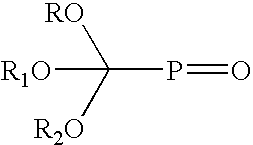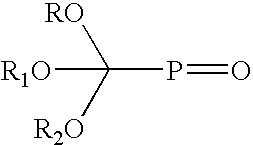Benzofuranone stabilization of phosphate esters
a technology of phosphate esters and benzofuranone, which is applied in the field of alkylphenyl esters of phosphoric acid, can solve the problems of undesirable discoloration, unsatisfactory material produced when applied to mixed alkylphenols produced, and product discoloration
- Summary
- Abstract
- Description
- Claims
- Application Information
AI Technical Summary
Benefits of technology
Problems solved by technology
Method used
Image
Examples
example 1
[0025] In this Example a phosphate ester sample (PHOSFLEX 31L) was treated with varying amounts of the lactone based stablizer (HP 136) to determine the color stability of the material. Accelerated color stability measurements were done at 80° C. for twenty-eight hours in a closed sample bottle. Results of this test are summarized in Table 2. It is clear from this measurement that in the concentration range 10-50 ppm (by weight), the stabilizer is effective in decolorizing and stabilizing the phosphate ester sample. The sample without the additive tested under the same conditions developed significant color—APHA of over 300. The starting color for this sample was about 50 APHA.
TABLE 2Results of the stability tests in the additiveconcentration range 10-50 ppm. Tests were done at80° C. for 28 hours.AdditiveAmountColor At End of Test(ppm)(APHA)0361102730195021
example 2
[0026] In this Example a phosphate ester sample (PHOSPHLEX 21L) was treated with varying amounts of the lactone based stabilizer (HP 136) to determine the color stability of the material. Accelerated color stability measurements were done at 80° C. for twenty-eight hours in a closed sample bottle. Results of this test are summarized in Table 2. It is clear from this measurement that in the concentration range 10-50 ppm (by weight), the stabilizer is effective in decolorizing and stabilizing the phosphate ester sample. The sample without the additive tested under the same conditions developed significant color: APHA of over 300. The starting color for this sample was about 50 APHA.
TABLE 3Results of the stability tests in the additive concentration range10-50 ppm (by weight). Tests were done at 80° C. for 28 hours.Additive Amount(ppm)Color At End of Test (APHA)032710215021
example 3
[0027] In this Example a phosphate ester sample (PHOSFLEX 21L) was treated with the lactone based stabilizer (HP 136) at levels of about 100 ppm to determine the color reduction efficiency and stability of the material. Accelerated color stability measurements were done at 80° C. for twenty-eight hours in a closed sample bottle. At this level of stabilizer, the color of the sample was reduced from about 200 APHA to about 25 APHA. The material was stable at this color level for an extended period of time at the described test conditions. This clearly demonstrated that the lactone additive was efficient in both reducing the color and in stabilizing the material against color formation.
PUM
 Login to View More
Login to View More Abstract
Description
Claims
Application Information
 Login to View More
Login to View More - R&D
- Intellectual Property
- Life Sciences
- Materials
- Tech Scout
- Unparalleled Data Quality
- Higher Quality Content
- 60% Fewer Hallucinations
Browse by: Latest US Patents, China's latest patents, Technical Efficacy Thesaurus, Application Domain, Technology Topic, Popular Technical Reports.
© 2025 PatSnap. All rights reserved.Legal|Privacy policy|Modern Slavery Act Transparency Statement|Sitemap|About US| Contact US: help@patsnap.com


